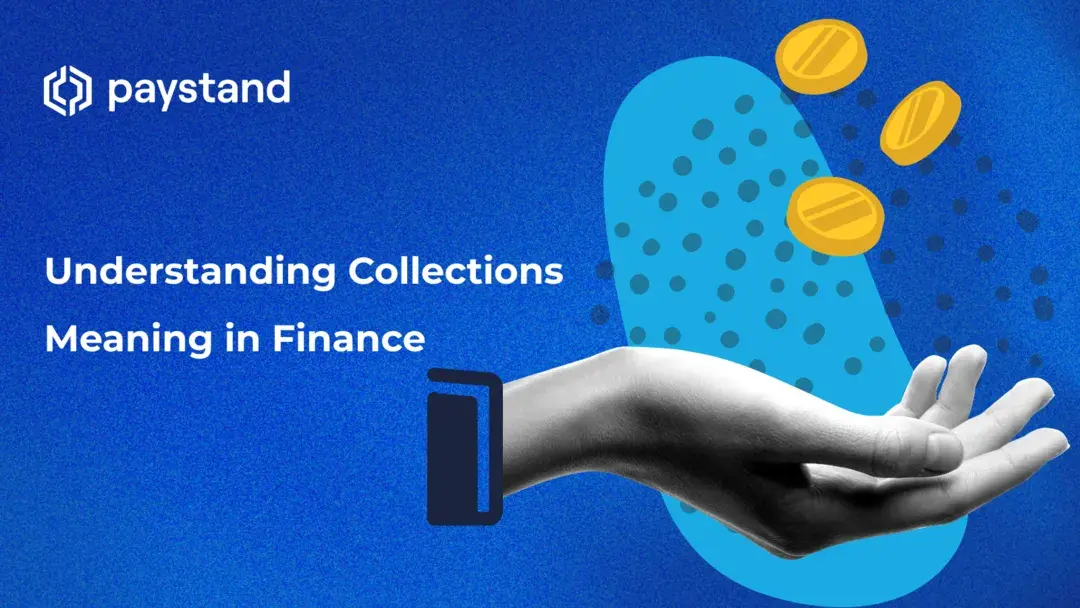Understanding Collections Meaning in Finance

Table of Contents
- What are collections in financial terms?
- What is an example of collections in finance?
- Are collections the same as debt?
- How does a business undergo Its collections process?
- How do businesses measure the success of their collections?
- What can finance teams learn from the AR turnover ratio?
- How can finance teams recover overdue collections?
- What happens when AR departments cannot collect what’s owed?
- Paystand: revolutionizing AR
Key Takeaways
- Collections involve tracking payments, sending reminders, negotiating resolutions, and taking legal action if necessary.
- Banks handle collections, such as cheques, direct debits, lockbox services, and electronic transactions like ACH and wire transfers.
- Collections differ from debt, as collections focus on recovering owed money, while debt refers to a legal obligation to repay borrowed funds.
- Metrics like collection rate, days sales outstanding (DSO), and bad debt expense measure the success of a company's collections.
- Businesses can prevent overdue collections through efficient AR practices, including offering discounts for early payments and creating payment plans.
- When a company cannot recover overdue payments, a collections agency may take over the process, purchasing the debt at a discount and recovering it on the company’s behalf.
Maintaining a healthy cash flow is crucial to success in the fast-paced world of finance. But what happens when payments are delayed or debts start piling up? This is where collections come into play—a process that ensures businesses recover what they’re owed while maintaining strong financial standing. Whether you're in accounts receivable management or just looking to better understand this vital aspect of finance, learning about the collections process can help you avoid potential financial pitfalls.
Continue reading to dive deeper into the different types of collections, key processes, and how automation can transform how your team manages payments and debt recovery.
What Are Collections in Financial Terms?
In financial terms, collections refer to gathering and managing debts owed to a business or organization. It involves retrieving outstanding payments from customers, clients, or other entities. The primary objective of collections is to ensure timely payment of invoices, reduce delinquent accounts, and maintain a healthy cash flow for the business.
The collections process typically includes several key steps:
-
Payment tracking: Companies track payments due from customers by monitoring accounts receivable, including invoices, payment terms, and due dates.
-
Payment reminders: Collection professionals contact overdue customers through email, phone, or letters.
-
Negotiation and resolution: Collections professionals assist customers with payment difficulties by negotiating plans, settlements, or discounts.
-
Legal action: Businesses may take legal action, such as filing lawsuits or involving collection agencies, to enforce payment from customers who consistently fail to pay their debts.
-
Collection agencies: Businesses sometimes outsource debt collection to specialized third-party agencies. These agencies recover debts through skip tracing, asset investigation, and legal actions.
Types of Collection in Banking
There are several types of collections commonly handled by banks:
- Cheque: When a customer deposits a cheque, funds are collected from the drawee collection bank or clearinghouse mechanisms.
- Bill: Payment processing involves banks acting as intermediaries to receive and credit customer payments to bill issuers' accounts.
- Documentary: Banks are intermediaries in international trade. Upon presenting shipping documents, the exporter's bank collects payment from the importer's bank.
- Direct debit: It allows customers to authorize businesses to automatically debit their bank accounts for regular payments like bills, loans, or subscriptions. The bank processes these payments based on the customer's instructions.
- Lockbox: Banks offer lockbox collection, a service for businesses receiving many payments by mail. Customers send payments to a dedicated post office box, which the bank collects and credits to the business account.
- ACH: It is an electronic system for processing low-value transactions, enabling businesses and individuals to initiate debits or credits from bank accounts via electronic files.
- Wire transfer: This method allows for fast, secure electronic fund transfers between banks, which credit the recipient's account.
- Point-of-Sale (POS): POS collection accepts electronic payments at the point of sale using devices like credit card readers.
What is an Example of Collections in Finance?
In B2B, collections are crucial for maintaining healthy cash flow and managing accounts receivable. Here's an example to illustrate how they work:
- Company A sells products to Company B, a distributor, with a 30-day payment term.
- Company A issues an invoice to Company B for shipped products. The invoice serves as a formal payment request.
- Company A's collections department ensures timely invoice payments from Company B by sending reminders, contacting accounts payable, and resolving disputes.
- Company A can implement clear payment policies to streamline collections, such as requiring credit references or setting up an online portal.
- If Company B doesn't pay the invoice on time, Company A may take further collection actions like:
- Send a formal demand letter with the outstanding balance and late fees.
- Contact Company B's management to resolve the payment issue.
- Engaging a third-party collection agency to assist in recovering the debt.
- Legal action (e.g., lawsuit) as a last resort against Company B.
Are Collections the Same as Debt?
Collections and debt are often used interchangeably, but they are different. While both involve money that is owed, the two have key differences.
| Collections | Debt |
|---|---|
| Involve creditors or third-party agencies in recovering money owed to them for any debt. | Is a legal obligation to repay borrowed money. It can be secured or unsecured. Common types include mortgages, car loans, student loans, and credit card debt. |
💡Key Differences
- Legal obligation: Debt is a legal obligation to pay back money that has been borrowed. Collections are the process of attempting to recover money that is owed.
- Collateral: Debt can be secured (backed by collateral) or unsecured. Collections cover both types.
- Statute of limitations: The law varies by state and limits the time a creditor can collect a debt.
- Credit report: Debt and collections can appear on credit reports and affect a person's credit score, but collections are less damaging.
How Does a Business Undergo Its Collections Process?
Efficient collections are crucial for risk minimization in finance. The AR team should prioritize on-time payments and implement a thorough credit approval process. Suitable accounting software can improve collection organization and timeliness.
Automating the AR department enhances collections, minimizes errors, automates tasks, reduces costs, and frees up the finance team for strategic planning. Aging reports categorize outstanding customer balances based on past-due status, enabling businesses to refine collection strategies for improved performance.
How do Businesses Measure the Success of Their Collections?
Businesses measure the success of their collections in a variety of ways. Some common metrics include:
- Collection tate: It measures the efficiency of a business in collecting outstanding invoices within a given period, indicating healthy cash flow.
- Days Sales Outstanding (DSO): It measures the average days to collect payment on invoices. A low DSO indicates efficient collection, while a high DSO suggests collection or customer payment issues.
- Bad Debt Expense: It reflects uncollectible accounts. Low expense shows effective credit and collection policies, while high expense suggests credit approval or collection issues.
- Customer Satisfaction: This metric measures customer satisfaction with the collection process, indicating a positive business experience without aggressive tactics.
- Return on Investment (ROI): It measures the financial return of a business's investment in its collection department. A high ROI indicates efficient collection operations.
What Can Finance Teams Learn From the AR Turnover Ratio?
Once the AR turnover is calculated, finance teams must understand the results and how they directly impact their business. A large number is a positive sign for the company's overall financial well-being. A high number reveals that the industry is converting more credit sales into actual revenue.
On the other hand, a smaller number indicates poor financial health because the business is converting a smaller percentage of its credit sales directly into revenue that can be used to sustain the business.
How Can Finance Teams Recover Overdue Collections?
A dunning letter is a collection notice sent to customers to show that their payments are overdue. It collects outstanding past-due receivables and prevents accounts from becoming delinquent.
Businesses can also ensure that outstanding collections do not become past due by creating a more efficient AR department, streamlining collection processes, offering customers things like discounts if payments are made early, or offering customers payment plans to help make paying off what’s owed easier.
What Happens When AR Departments Cannot Collect What’s Owed?
When an invoice remains outstanding and the AR department fails to collect a payment, the amount due may be passed to a collections agency. A collections agency is a third party that purchases the debt at a discount, allowing the business to recoup some of what is owed without spending time pursuing it. The agency is responsible for collecting the payment from the debtor and can pursue the debt indefinitely or until the statute of limitations expires. The collection process varies depending on the company collecting the debt, the amount owed, and the type of debt.
Paystand: Revolutionizing AR
At Paystand, we understand that an efficient collections process is essential for maintaining cash flow and reducing the burden on finance teams. Our cutting-edge AR automation tools streamline collections, ensuring payments are tracked, processed, and recovered swiftly—all while reducing manual errors. Ready to optimize your collections process and empower your AR team?
Download our ebook to discover how finance automation can elevate your business, or follow our quick guide to accounts receivable management.






